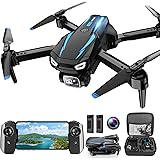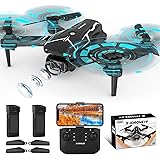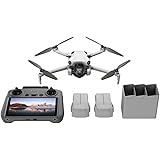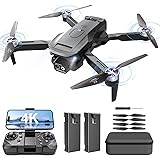The landscape of modern defense and security is continually being reshaped by technological advancements, with Unmanned Aerial Systems (UAS) standing at the forefront of this evolution. As demonstrated in the accompanying video, Redcat is positioned as a pivotal American drone solutions company, dedicated to developing small tactical reconnaissance drones for a myriad of defense and security applications. These solutions are not merely about advanced technology; at their core, they are purposed with the critical mission of saving lives and ensuring the safe return of personnel from hazardous situations. The strategic importance of robust, intelligent, and adaptable drone technology in contemporary conflict zones cannot be overstated, influencing everything from reconnaissance to precision strike capabilities.
Established in 2016 by CEO Jeff Thompson, Redcat has experienced significant growth, expanding its operational footprint to include two key subsidiaries: Teal Drones, based in Salt Lake City, Utah, and Flightwave Aerospace, situated in Long Beach, California. With a workforce ranging between 100 and 120 employees, the company maintains a distinctive business model. This approach is characterized not by attempting to do everything internally, but by focusing on its core strengths in drone technology development. Redcat intentionally partners with other leading companies to integrate “best in breed” software applications, thereby creating a comprehensive ecosystem of innovation tailored for the warfighter.
Advanced Tactical Drone Solutions: The “Flying Cell Phone” Concept
Redcat’s innovation is often conceptualized as a “flying cell phone,” a paradigm shift that allows tactical drones to operate with the same modularity and application-driven utility found in personal smart devices. This foundational concept enables warfighters and defense personnel to access a suite of advanced software applications directly on their drone platforms. These applications are critical for enhancing situational awareness and operational effectiveness in complex environments. By integrating such versatile software, the utility of these tactical drones is significantly expanded beyond basic flight capabilities, providing sophisticated tools at the user’s fingertips.
Key among these integrated applications are artificial intelligence (AI) and machine learning (ML), which are employed for crucial tasks such as target identification and classification. Moreover, capabilities like 3D mapping and advanced imagery analysis are seamlessly integrated, offering a comprehensive view of the operational theater. The strategic decision to collaborate with partner companies for these software solutions ensures that Redcat’s drones are always equipped with the latest and most advanced technologies. This collaborative model not only accelerates development but also guarantees that specialized software, from AI-driven analytics to precise mapping tools, meets the highest industry standards, delivering unparalleled capability to the frontline warfighter.
Introducing Redcat’s ISR Drone Platforms
Among Redcat’s suite of defense drones, two prominent platforms are designed to meet diverse operational requirements for intelligence, surveillance, and reconnaissance (ISR). Each platform is engineered with specific features to address the multifaceted challenges encountered by military and security personnel. The careful design ensures adaptability and superior performance across various mission profiles, contributing significantly to tactical advantage on the battlefield. These tactical drones are robust, offering enhanced capabilities.
The Black Widow: A Robust Short-Range Reconnaissance Drone
The Black Widow is a small tactical short-range reconnaissance drone that has garnered significant recognition, including its recent selection for the US Army’s Short Range Reconnaissance Program of Record. This achievement underscores its robust design and advanced capabilities. The drone offers an impressive flight time of approximately 35 minutes and a range of 5 to 8 kilometers, making it ideal for immediate, localized intelligence gathering. A standard feature is the inclusion of a Teledyne FLIR 640 plus R day and night payload, which provides high-resolution thermal and day imagery, crucial for operations in varying light conditions.
A significant differentiator for the Black Widow is its Electronic Warfare (EW) resilience, largely attributed to its integrated Doodle Labs radio. This advanced radio system enables frequency hopping between M1 and M6 frequencies, allowing the drone to maintain connectivity even in highly contested electromagnetic environments. This capability was notably proven during testing in Ukraine, where the Black Widow performed exceptionally well against Russian jammers. Furthermore, the Black Widow is engineered for extreme field repairability; if a component like a motor arm is damaged, it can be quickly replaced by a warfighter in the field, eliminating the need to send the entire unit back to the factory. This design philosophy minimizes downtime, ensuring that valuable assets remain operational when they are most needed.
Edge 130: Hybrid VTOL for Extended Missions
Developed by Flightwave Aerospace, the Edge 130 represents a cutting-edge hybrid VTOL (Vertical Take-Off and Landing) tricopter design. This unmanned aerial system is particularly innovative because it takes off vertically, akin to a helicopter, and then seamlessly transitions to forward flight using its propulsion system. This design confers a unique advantage, combining the flexibility of vertical launch with the efficiency of fixed-wing flight, making it highly adaptable for various deployment scenarios. The Edge 130 is also notably light, weighing even less than the Black Widow, which enhances its portability and operational agility.
The Edge 130 comes standard with two distinct payload options: a mapping array with multiple camera systems for detailed mapping and 3D mapping, and another nose payload dedicated to day/night ISR imagery, similar to the Black Widow. With an impressive flight time of approximately one hour and a range of 20 kilometers, it offers significantly extended endurance and reach. Future enhancements are already planned to increase its flight time to 90 minutes and potentially two hours, alongside further expanding its range beyond 20 kilometers. These continuous improvements ensure that the Edge 130 remains best-in-class for its size, providing extended operational capabilities for complex, long-duration missions. Efforts are also underway to integrate this platform into maritime environments, allowing for launch from ships and unmanned surface vessels to support multi-domain operations.
The Warfighter Electronic Bridge (WEB) Controller and Future Capabilities
The Warfighter Electronic Bridge (WEB) serves as the standard controller for the Black Widow system, representing a sophisticated interface for managing drone operations. This advanced controller is designed to evolve, with future developments expected to expand its capabilities significantly. Upcoming versions of the WEB will allow for the control of multiple air vehicles simultaneously, including the Edge 130, and even specialized FPV (First Person View) precision strike drones that are currently in development.
Beyond aerial assets, the WEB system is also being engineered to operate ground robots, fostering a truly integrated robotic force. Furthermore, it will facilitate swarming capabilities, enabling synchronized deployment and control of multiple drones for complex missions. This represents a monumental step toward enhanced battlefield autonomy and coordination. The adaptability of the WEB controller ensures that warfighters are equipped with a single, versatile tool capable of managing an entire ecosystem of unmanned systems, thereby simplifying operations and increasing mission effectiveness. The development of such integrated control systems is paramount for future multi-domain operations.
Redcat’s Ecosystem of Innovation: The Futures Initiative
Redcat’s commitment to delivering unparalleled defense solutions is further exemplified by its strategic collaborative approach, notably through the Red Cat Futures Initiative. This industry consortium, established last year, brings together a collective of best-in-breed drone technology companies. Its primary objective is to create a unified platform where these leading companies can engage directly with government entities, ensuring that the needs of defense and security are met with cutting-edge, integrated solutions. This initiative positions Redcat as a central hub, focusing on core drone technology while leveraging the specialized expertise of its partners.
Several impactful partnerships illustrate the consortium’s breadth and innovation:
- Ocean Power Technologies: This collaboration focuses on integrating Redcat’s drones with unmanned surface vessels (USVs), enabling multi-domain operations for maritime applications and swarming capabilities over water.
- Athena AI (Australia): Athena AI specializes in target identification and classification, helping to build sophisticated target models that are injected into Redcat’s drones. This allows the drones to autonomously identify people, objects (such as shovels or weapons), and vehicles in real-time.
- Reveal Technologies: Through their Farsight software, 3D mapping capabilities are enhanced. Drones can fly over an area, capturing 360-degree imagery to create real-time, highly relevant 3D maps crucial for mission planning and execution.
- Sentient Robotics: This partnership is centered on developing advanced swarming technologies. Sentient’s “hive technology” allows for the deployment of anywhere from 12 to 80 drones to execute a mission, return for recharge, and then redeploy, showcasing a high level of autonomous coordination.
Developing the Portable Kill Chain: FPV Precision Strike Drones
In a significant expansion of its capabilities, Redcat is actively moving into FPV (First Person View) technology, with a new line of precision strike FPV drones, known as FANG, having been announced at Eurosatory last year. These drones are currently under development and are expected to be released in the coming months. The FANG drones are designed to operate in conjunction with existing ISR assets, creating a streamlined and highly effective “portable kill chain” for warfighters. This revolutionary concept bridges the gap between target identification and engagement, dramatically reducing response times.
The operational scenario involves an ISR drone identifying a target through its advanced AI software, which then classifies the target as a threat. Traditionally, this would necessitate calling in larger air assets like helicopters or gunships, a process that can be time-consuming. With Redcat’s integrated approach, warfighters will now have the immediate capability to not only locate and identify a target but also to engage it directly using these small, precision strike FPV drones. This capability provides an agile, localized, and rapid response solution, significantly enhancing the warfighter’s operational autonomy and effectiveness in dynamic combat environments. Such advanced battlefield drones are pivotal for modern engagements.
Redcat’s Unwavering Commitment to Security and Reliability
Redcat distinguishes itself through an uncompromising commitment to security, reliability, and field effectiveness. For organizations seeking robust and trustworthy drone solutions, Redcat positions itself as the unequivocal choice. The company’s drones are engineered with AES 256 encryption, ensuring that all data transmission is 100% secure, a critical feature for sensitive defense and security operations. This high level of encryption protects vital intelligence from interception and exploitation, providing peace of mind for frontline operators. Furthermore, the design philosophy prioritizes the frontline warfighter, making the drones not only ruggedized but also eminently field-repairable. This contrasts sharply with many competitors whose drones, if damaged, require a full return to the factory, leaving warfighters without crucial assets. Redcat’s design ensures rapid repairs can be performed directly in the operational theater, maximizing uptime and mission continuity.
The inherent adaptability of Redcat’s drone platforms, combined with its industry consortium model, guarantees that customers receive access to best-in-breed technology. As software continuously improves and new applications emerge, these enhancements can be seamlessly integrated into existing drone systems, providing a future-proof solution. For those whose mission requirements prioritize data safety, battlefield resilience, and access to the latest technological advancements, Redcat stands ready to provide sophisticated and reliable defense drones. The emphasis on ruggedization, field repairability, and state-of-the-art encryption solidifies Redcat’s position as a premier provider of tactical drone solutions, designed to meet the rigorous demands of military and security operations worldwide.











